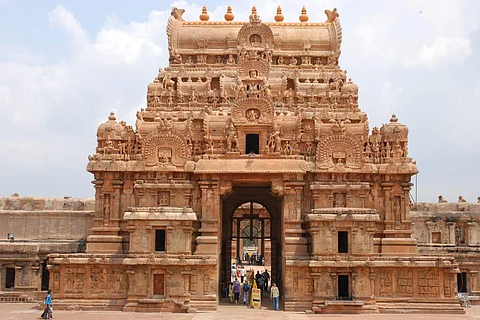

Watching Ponniyin Selvan: I, the magnum opus of ace director Mani Ratnam, evoked memories of my temple-hopping spree in the Cauvery delta, the cultural heartland of Tamil Nadu, a legacy bequeathed by the glorious Chola kings. The delta is scattered with the vestiges of the Cholas’s golden age, especially in their capital, Thanjavur. On our visit to Thanjavur, we marvelled at the Brihadeshwara temple, built by Chola emperor Rajaraja Chola I, its magnificent gopuram dominating the cityscape. Built in the 11th century, the Periya Kovil (Big Temple), as it is popularly known, is Tamil Nadu’s most awe-inspiring Chola monument. It is one of three similar temples built by successive kings, the other two being at Gangaikondacholapuram and Darasuram, all UNESCO World Heritage Sites.
Before we set out to explore the temple, our guide Raja narrated the origin myth of Thanjavur. “Thanjavur, or Thanjan’s ‘ooru’, is the town named after the demon Thanjan. According to legend, he was slain by Lord Vishnu on the banks of the Cauvery. As he lay dying, Thanjan prayed to Vishnu that a town of great beauty emerge at the spot where he was killed and that it be named after him. His wish was granted and Thanjan’s ooru was born.”
Two exquisitely sculpted archways herald a welcome to the sprawling temple complex, which is surrounded by a moat that is now dry. The outer façade of the inner gateway features two enormous dwarapalakas (doorkeepers) with beguiling smiles carved out of single stones. They lead to a vast courtyard in which the main temple stands. Separated by a corridor and facing the sanctum is the 12-feet-tall monolithic idol of Nandi.
With a sandstone colour finish, the temple looks grand and opulent. Inside the sanctum sanctorum stands the four-metre-tall Shivalingam, possessing a circumference of seven metres. As we circumambulated in the corridors around the sanctum, we observed many sculptures as well as large mural paintings depicting the marriage of Shiva and Parvathi.
The vimana — which is the pyramid structure over the sanctum — has a 14-storey tower and is over 216 feet tall. A beautifully carved octagonal dome with a gilded kalasa covered in gold-plated copper crowns the vimana. The gigantic dome is believed to have been hauled across a 6-km-long ramp, similar to how the Great Pyramids of Egypt were believed to have been constructed. The complexities of the architecture and the unparalleled engineering feat took my breath away.
The inscriptions in Tamil at the base of the main shrine give amazingly detailed information about the organisation of the temple. What intrigued me was that Rajaraja Chola I even had the names and addresses of all his dancers, musicians, poets and barbers recorded on the temple wall — a testimony of the significance given to the development of the arts.
Some of the inscriptions at the temple
We also visited the subsidiary shrines of Varaha, Ganesha, Karuvur Thevar, Subramanya and Chandikesvara. The beautiful Murugan (Subramanya) temple built like a chariot deserves special mention. This temple was a later addition and was probably built by one of the Nayak kings of Madurai. This is a small and exquisite temple, full of sculptural ornamentation. The shrine dedicated to Karuvur Thevar, who consecrated the temple, has been built to resemble a cave.
Just before we completed our temple darshan, we visited the museum inside the complex, where one can see charts and maps detailing the history of the Chola empire as well as some interesting sculptures and photographs of the temple prior to restoration.
One of the murals painted on the walls
One can spend endless hours gawking at the stunning beauty of the temple’s stone work and the absolute wealth of sculptural details. But there are other attractions to explore in Thanjavur like the royal palace of the Nayak kings, the Saraswathi Mahal Library, the Rajaraja Museum and Art Gallery, all located a little distance from the Brihadeshwara temple.
All pictures by Susheela Nair
Susheela Nair is an independent food, travel and lifestyle writer and photographer contributing articles, content and images to several national publications besides organising seminars and photo exhibitions. Her writings span a wide spectrum which also includes travel portals and guide books, brochures and coffee table books.